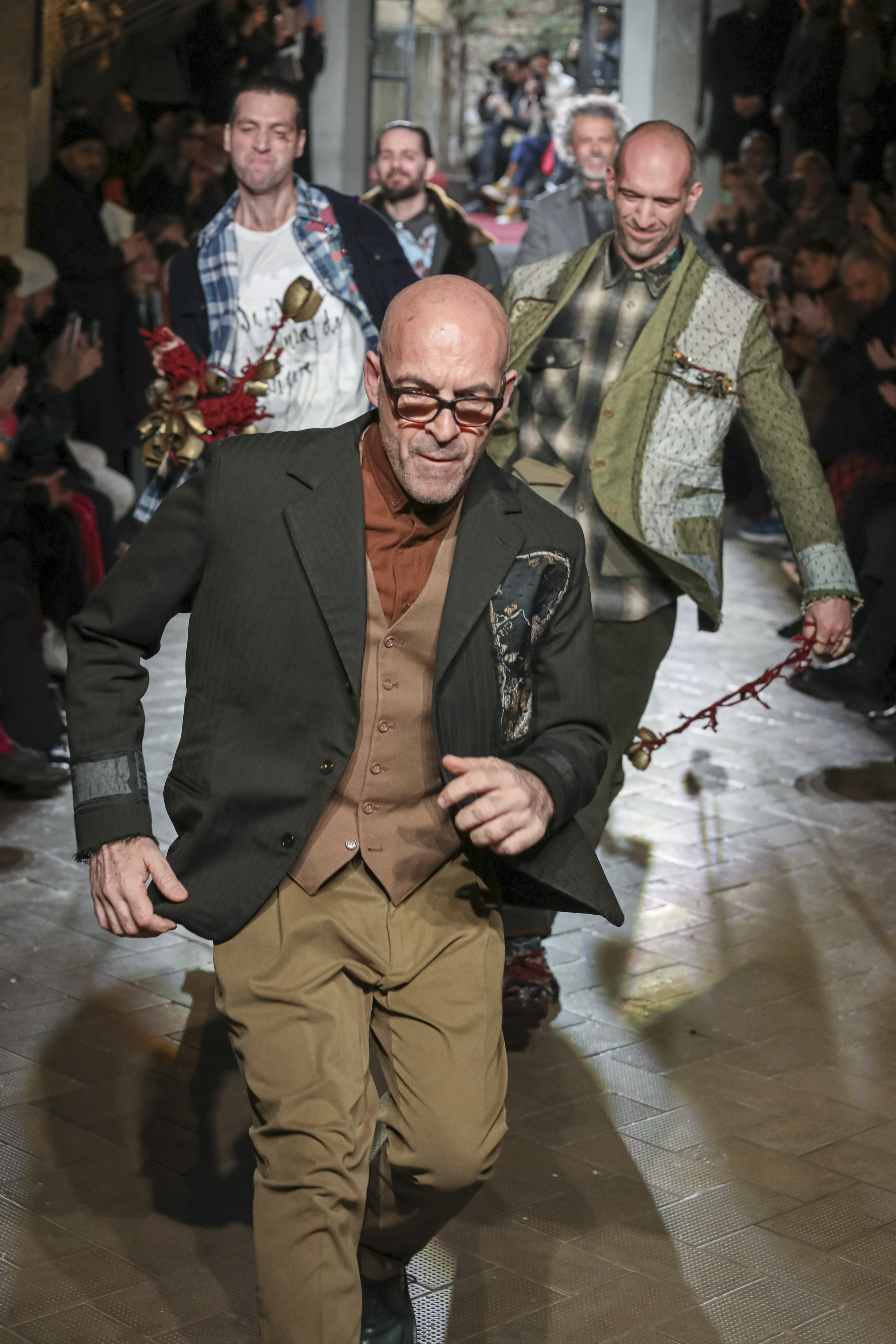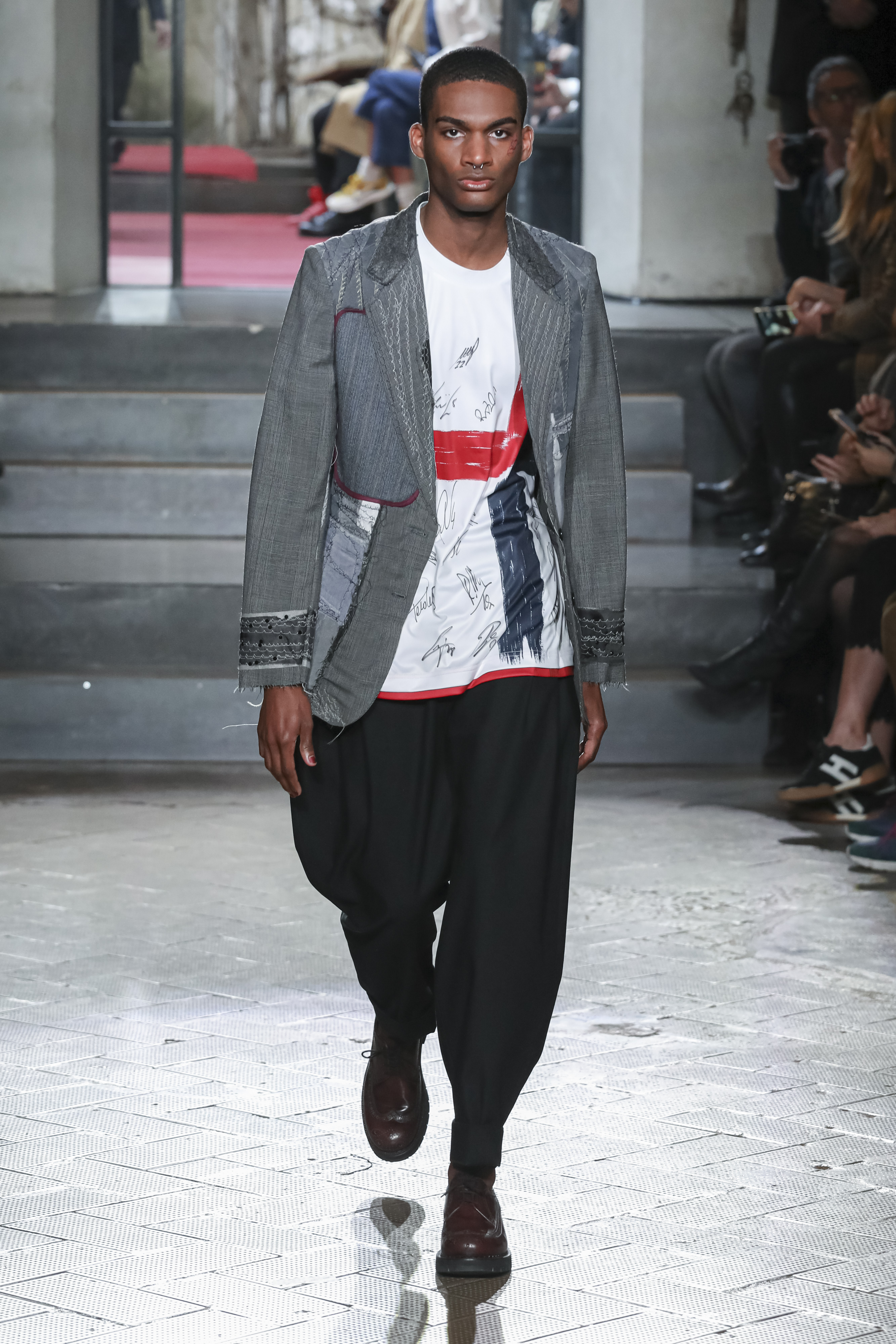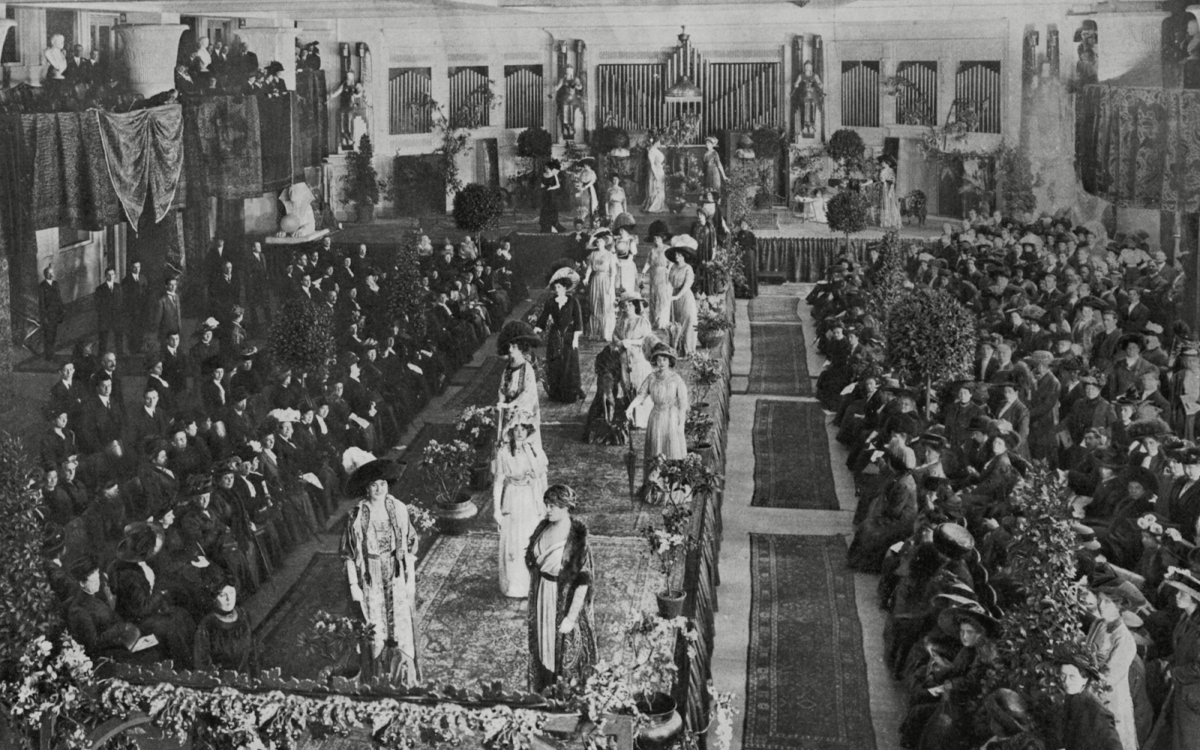Antonio Marras – F|W 2020 – The crazy sewing machine and the sparkling Jan
The Domus’ ladies also loved sewing clothes for their men. The Janas man is a living oxymoron. He is precious yet resigned, authoritative yet humble, elegant yet scruffy, serious yet futile, refined yet essential, demanding yet very easy. He is order and chaos. He wears work-shirts and illustrated tailored jackets.
He wears jeans and he wears them inside-out. And he loves decorated and embroidered sweaters. The man deals with the complexity of the woman and her typical stratifications. One day something extraordinary happened changing everyone’s fate in the village of the Janas. It is known that many leave town of Janas but sooner or later they always come back.
So did Graziedda. She returned directly from London, this time, in company of a very stylish gentlemen: John. The two, enchanted with the “London Calling” fashion scene, arrived with astonishing novelties on style and decor. But the true revolution came around, as John’s profession happened to be the selling of sewing machines.
With convincing arguments about quality, progress and efficiency, John managed to quickly sell a sewing machine to each of the Domus’ women. He spoke about all possibilities: patching, adjusting, changing, unding and rebuilding any kind of garment in half the time, compared to what they did before. However, the Janas still did not know how to properly use the sewing machines.
As a result one of the machines revolted and went mad. It rolled around, sewing like crazy, scattering anywhere all kinds of threads, anarchist traces and unruly knots. Only Graziedda managed to finally take control of the crazy sewing machine, creating unique and splendid garments. Since then Graziedda was called the “Sparkling Jana”, teaching everyone how to handle the machines. The Janas lived happily ever after, sewing and creating. Even the crazy-sewing machine found its place and stayed with them forever.

Antonio Marras Ready To Wear Fashion Show, Collection Fall Winter 2020 in Milan
Photo by Valerio Mezzanotti
DEDICATION
The collection “The crazy sewing machine and the sparkling Jana” is dedicated to Maria Lai. Maria Lai assembles, joins, sews and embroiders pages, words, images intertwining stories and speeches and weaves relationships. Maria invites us to abandon the usual paths, the already-known order. She suggests discovering meanings that were once ancient and new, universal and individual. Maria Lai is a Jana, a Sardinian fairy. She sews with golden threads and weaves the loom inserting shiny crystals and precious stones. She holds by hand the sun and the shadows and she tangles us to fairy tales, to dreams and to the infinite. “Light, reverberations, flashes, reflections, incandescences. There is nothing more exquisite than giving light to a garment. Swarovski enables you to do so. And it is with light that a dress comes to life.”
SYNOPSIS
Once upon a time there was an island in the middle of the Mediterranean. Right at the very center of the island there was a little village. In the heart of this village there was a very large, beautiful house called Domus de Jana. Here all women from the village gathered to sew, embroider, trim and work the loom. It was a great, a moment of gathering, working together, chatting and singing.
Their favourite song was “Mio Cuore” (My Heart), which they kept as loud as they could. All women had a precious, very special gift: they had fairy, magical hands. They sewed, weaved and embroidered as no one else in the entire world. By then, everyone called them “the Janas”, the Sardinian fairies who sew with golden threads. People from all parts of the island and from the continent, kept coming to the village and pay visit to the Janas, who then carefully manufacture high-quality, very special and unique clothes.
The women from Domus de Jana loved sparkling crystals, fine laces, extraordinary embroideries, precious glittery stones, exuberant ruffles, inlays and other dazzling decorations. As small meticolous bees they would recover everything they would find: feathers from large birds, dried flowers, nets, scraps from diverse fabrics and dried leaves.
They would weave them with swarovski gifts . The ones they would madly love for the brilliance and their multicolored shimmer. The Janas loved fabrics, all of them! Traditional festive fabrics but also the poor and mistreated ones for an everyday use. Above all they loved searching inside the deepest closets, finding all forgotten clothes and give them a new life.
The velvets, the precious brocades, the layered jacquards, various checked fabrics, classical prince-of-wales’ patterns, the eco-furs, the chantilly laces, the valencienne, rebrodè and macramé, the glimmery damask cloths, the tulle covered in golden polka dots, silk, wool and washed-out jeans, heavy cottons and flannels. Janas’ favorite colors were: purple red and crimson red, sage-green and dark-green, white and black, and te delicate ecru. And finally powder blue and pale pink

Antonio Marras Ready To Wear Fashion Show, Collection Fall Winter 2020 in Milan Photo by Valerio Mezzanotti
Photos: Antonio Marras Ready To Wear Fashion Show, Collection Fall Winter 2020 in Milan Photo by Valerio Mezzanotti
Ma un bel giorno avvenne una cosa straordinaria che cambiò le sorti del paese. Ritornò in paese Graziedda (perché molti se ne vanno ma poi tutti ritornano!). Graziedda tornò direttamente da Londra, accompagnata dal suo uomo londinese John, very stylish .Tutte e due, infatuati della scena londinese “London Calling”, ritornarono con grandi novità di stile e di decori.
Ma la vera rivoluzione fu dovuta al fatto che John era un venditore di macchine da cucire. In men che non si dica vendette ad ogni donna una macchina da cucire con le argomentazioni convincenti della qualità, del progresso, del tempo risparmiato e della fatica evitata. Si poteva rattoppare, aggiustare, cambiare, fare, disfare e ricostruire tutti i capi in tempi dimezzati rispetto a prima. Ma le donne della Domus ancora non sapevano usarle bene e così d’un tratto, una delle macchine si ribellò e prese il sopravvento cucendo e correndo, come fosse impazzita, seminando tracce, grovigli, nodi e fili pendenti, strappi, interruzioni, tracciati indisciplinati e anarchici.
Solo Graziedda, dopo una lunga lotta, riuscì a cavalcare la macchina da cucire impazzita e realizzare dei capi unici e splendenti. Da allora Graziedda fu chiamata la “Jana splendente” che insegnò a tutti come governare le macchine ed usarle al meglio. Infine le Janas vissero per sempre felici e contente con i loro uomini e le macchine da cucire.
Photos: Antonio Marras Ready To Wear Fashion Show, Collection Fall Winter 2020 in Milan Photo by Valerio Mezzanotti
DEDICA
La collezione “The crazy sewing machine and the sparkling Jana” è dedicata a Maria Lai. Maria Lai assembla, congiunge, cuce e ricama pagine, parole, immagini intrecciando le trame delle storie e i fili del discorso e intesse relazioni. Maria invita ad abbandonare i tracciati consueti, l’ordine riconosciuto per scoprire significati a un tempo antichissimi e nuovi, universali e individuali. Maria Lai è una Jana, una fatina sarda, che cuce con i fili d’oro e tesse a telaio incastrando cristalli e pietre preziose e che tiene per mano il sole e l’ombra, che cuce e ci lega alle favole, ai sogni e all’ infinito. “ Luce, riverberi, bagliori, riflessi , incandescenze. Cosa esiste di più bello di poter illuminare un capo? Swarovski te lo permette. E con la luce un abito prende vita.
SINOSSI
C’era una volta un’ isola al centro del Mediterraneo. Al centro dell’Isola c’era un paese. Al centro del paese c’era una casa grandissima bella, bella chiamata Domus de Jana. Qui si riunivano tutte le donne del paese per cucire, ricamare e lavorare al telaio. Ed era una grande gioia lavorare insieme, tra chiacchiere e canti. Le donne erano specialmente fissate con la canzone “Mio cuore” che cantavano a squarciagola tutte insieme. Le donne avevano un dono prezioso, molto speciale, avevano mani di fata. Cucivano, tessevano e ricamavano come nessun’altro al mondo. Ormai da tutti erano conosciute come le Janas, le fatine sarde che cuciono con fili d’oro. Da tutte le parti dell’Isola e dal continente arrivavano stuoli di donne e di uomini in paese per farsi confezionare abiti di altissima qualità, molto speciali e molto identificativi. Le donne di Domus de Jana amavano i cristalli che sbrilluccicano, i pizzi che impreziosiscono, i ricami che distinguono, le pietre preziose che luccicano, le ruches che adornano, gli intarsi che arricchiscono e i decori che abbelliscono.
E come delle piccole api operaie, le Janas recuperavano tutto quello che trovavano: piume delle mute dei grandi volatili, fiori secchi, spago, reti, ritagli di stoffa e foglie secche, che magari intessevano con i regali swarovski. Questi le facevano impazzire per la loro brillantezza, il riverbero e il rimbombo della luce multicolore. Amavano i tessuti, tutti! Quelli della grande tradizione delle feste e quelli poveri e bistrattati della vita di tutti giorni e soprattutto amavano ridare vita ai capi ormai abbandonati e dimenticati negli armadi. I velluti cangianti, i broccati pesanti, gli jacquard stratificati, i quadri, i galles classici, le pellicce ecologiche, i pizzi chantilly, quelli valencienne, rebrodè e macramè, i damaschi iridescenti, il tulle a pois dorati, twill di seta, il panno di lana cotta, le maglie lavorate e i jeans slavati, cotonacci e flanelle. I loro colori preferiti: il rosso porpora e il rosso cremisi, il verde salvia e il verde scuro, il bianco e il nero, l’ecrù.
Il celeste polvere e il rosa pallido. Le signore della Domus amavano cucire i vestiti per i loro uomini. L’uomo delle Janas è un ossimoro vivente. È prezioso e dimesso, autorevole e umile, elegante e trasandato, serio e futile, ricercato ed essenziale , impegnativo e facilissimo. Lui è ordine e caos. Veste camicie da lavoro a quadri e giacche sartoriali illustrate, i jeans messi al rovescio, ricamati e le maglie decorate. L’uomo fa i conti con la complessità della donna e con le sue tipiche stratificazioni

Antonio Marras Ready To Wear Fashion Show, Collection Fall Winter 2020 in Milan
Photo by Valerio Mezzanotti












































